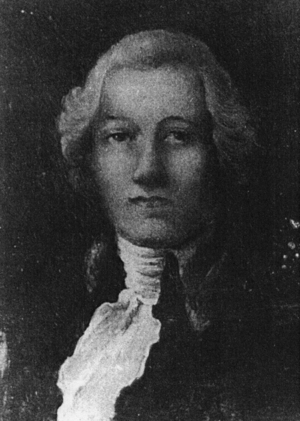Luis Née facts for kids
Luis Née (born July 12, 1735, died October 3, 1807) was a Spanish botanist, originally from France. He was an amazing plant collector! Luis Née joined the famous Malaspina Expedition, a five-year science trip around the Pacific Ocean. Besides studying plants, he was also a pharmacist who loved learning about plants used for medicine.
Contents
Early Life and Plant Discoveries
Little is known about Luis Née's early life. He was born near Paris, in Le Perray-en-Yvelines, to a working-class family. Even though he had only a basic education, he showed a strong interest in plants and collecting them from a young age. He later moved to Spain and became a Spanish citizen.
By 1772, Née was working at a pharmacy in a monastery. He spent his free time collecting plants in the mountains of Santander and Asturias. In 1777, he started working for Casimiro Gómez Ortega, who was in charge of the botanic gardens in Madrid. Née collected plants and studied in their library. In 1780, he became the main pharmacist for the army in Gibraltar. He even created a garden of medicinal plants for a hospital and wrote a book about his plant observations in Andalucía.
Née kept collecting plants in places like Málaga, Algeciras, Gibraltar, and Andalucia. He didn't just collect dried plant samples for study; he also gathered live plants to grow in his own gardens. He was so good at gardening that in 1784, the King asked him to create a new botanic garden in Pamplona.
Joining the Malaspina Expedition
In 1788, Alessandro Malaspina, a Spanish Navy officer, asked the Spanish government to support a big science trip. This expedition would visit almost all Spanish lands in the Americas and Asia. King Charles III, who liked to support science, approved the trip, which became known as the Malaspina Expedition.
Malaspina wanted three naturalists (scientists who study nature) for his team. He first hired Antonio Pineda and Thaddeus Haenke. Pineda was chosen as the lead naturalist. He suggested that Luis Née should fill the third spot. On February 4, 1789, King Charles IV officially named Née as a botanist for the expedition.
Setting Sail and Exploring South America
The expedition, with two ships, left Cadiz on July 30, 1789. Née was on the ship called Atrevida. Pineda was on the second ship, Descubierta. Haenke missed the start but joined them nine months later.
Their first stop was in Montevideo. Then they sailed around South America, stopping in places like Patagonia, Chile, Peru, Panama, and Nicaragua. At each stop, Née spent days or weeks collecting plants in the area. Once, Née and Pineda even tested a local plant on themselves, which made them very sick!
Plant Collecting in Mexico and Asia
When they reached Acapulco, Mexico, on March 27, 1791, Née and Pineda stayed there for a long time to collect plants. Meanwhile, the expedition continued along the coast to Alaska. Over the next six months, Née collected almost 3,000 plant samples while traveling over 1,500 miles across Mexico. Malaspina returned to Acapulco in December 1791 to pick up Née and Pineda before heading west to Asia.
Six weeks later, they arrived at the Marianas Islands. There, Née collected several rare plants that he later wrote about. From there, they sailed to the Philippines, reaching Sorsogon Bay in early March 1792. Née really wanted to explore the inside of the island. So, he arranged to be left at Sorsogon Bay and traveled alone to Manila, where he met the expedition three months later. In the Philippines, he collected about 2,400 plant samples and kept a journal about nature, farming, and local customs. Sadly, Pineda became very ill on a separate trip and died.
Journey Home
After the Philippines, the two ships visited Australia, New Zealand, and Tonga. Then they sailed back across the Pacific Ocean to South America. From Chile, Née again left the main expedition. He traveled by land across Chile and Argentina to meet the team in Montevideo. This was their last stop. War was starting in Europe, and Malaspina was told to get his ships ready for battle and return home. They reached Cadiz on September 21, 1794, finishing a journey that lasted more than five years.
Life After the Expedition
Née stayed in Cadiz until December, organizing the huge number of plant samples collected during the expedition. He believed he had personally collected over 12,000 samples! Most of these came from Mexico (2,900), the Philippines (2,400), and Peru (1,600). Much of this collection was sent to the Royal Botanical Garden of Madrid, where his friend Antonio José Cavanilles was in charge. Née's collection became the main part of the Royal Botanic Gardens' plant collection.
Even though he planned to study and describe all the plants, Née didn't publish many books on his own. However, he did help Cavanilles with his plant studies. After getting a pension (regular payment) in 1801, Née started publishing regularly in a science journal called Anales de Ciencias Naturales. He described several new plant species, including Quercus agrifolia (coast live oak) and Quercus lobata (valley oak), both from California. Sometimes people mistakenly think Née visited California, but these plants were collected by others on the expedition while he was in Mexico.
Most of Née's plant work stopped after 1804, and he passed away on October 3, 1807.
Née had two sons from two different marriages. In 1794, botanists José Pavón and Hipólito Ruiz named the plant group Neea in his honor. Later, in 1976, another botanist, Cyrus Longworth Lundell, named a plant group called Neeopsis after him as well. This group of flowering plants is found in Guatemala.
See also
- European and American voyages of scientific exploration
 In Spanish: Luis Née para niños
In Spanish: Luis Née para niños


